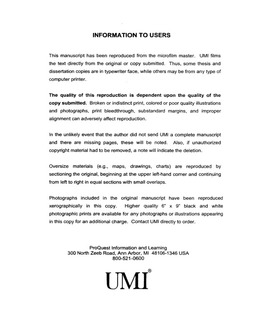| dc.contributor.advisor | Hertzke, Allen D., | en_US |
| dc.contributor.author | Hoffman, Donna Riddle. | en_US |
| dc.date.accessioned | 2013-08-16T12:18:21Z | |
| dc.date.available | 2013-08-16T12:18:21Z | |
| dc.date.issued | 2001 | en_US |
| dc.identifier.uri | https://hdl.handle.net/11244/351 | |
| dc.description.abstract | Critical realignment theory and its failure to appear in the contemporary American electorate is the focus of this work. The political changes in the electorate and their impact on realignment theory have been well documented. Others working outside the framework of realignment have increasingly noticed profound changes in contemporary society and the effect these social changes have on politics. What has been missing from studies that attempt to explain the lack of a critical realignment in the contemporary electorate is a discussion of broad societal forces that may be at play and the impact these forces may have on this theory of electoral change. Ronald Inglehart (1971, 1977, 1997) has long postulated that a value change is taking place in society that is profoundly affecting postindustrial politics. Both Inglehart's theory of value change and critical realignment theory have expectations of cleavage behavior within electorates. These two theories are reviewed and the voting behavior of various cleavages is documented from 1952--1998 using the American National Election Studies. Many cleavages are increasingly showing decreasing partisan cohesiveness as Inglehart predicted, yet some cleavages are enduring, contrary to Inglehart's expectations. Because of the inconsistencies in the performance of Inglehart's indicators, a test of his theoretical assumptions was conducted. A lack of congruence between Inglehart's measure of values and his theoretical assumptions was indicated. Therefore, another indicator of change, party platforms, was utilized. A significant change is found in the way parties addressed issues beginning in the 1990s that corresponds with the disintegration of the partisan cohesiveness of certain cleavages. In the 1990s, party platforms began polarizing on cultural issues that the majority of the electorate did not feel were of primary importance. However, these are the very issues that are important to the cleavages found to still be partisanly attached. There seems to be a connection between the dissipation of many cleavages, the endurance of other cleavages, and the way parties addressed issues in the 1990s. Critical realignments will not occur in an electorate that has insufficient enduring cleavages and where political parties do not polarize on many issues that substantial portions of the electorate feel are of primary importance. | en_US |
| dc.format.extent | vii, 247 leaves : | en_US |
| dc.publisher | The University of Oklahoma. | en_US |
| dc.subject | United States Politics and government 1945-1989. | en_US |
| dc.subject | Political Science, General. | en_US |
| dc.subject | Party affiliation United States History. | en_US |
| dc.subject | United States Politics and government 1989- | en_US |
| dc.subject | Elections United States History. | en_US |
| dc.title | Realignment theory in social perspective. | en_US |
| dc.type | Thesis | en_US |
| dc.thesis.degree | Ph.D. | en_US |
| dc.note | Adviser: Allen D. Hertzke. | en_US |
| dc.note | Source: Dissertation Abstracts International, Volume: 62-06, Section: A, page: 2226. | en_US |
| ou.identifier | (UMI)AAI3018336 | en_US |
| ou.group | Other | |
